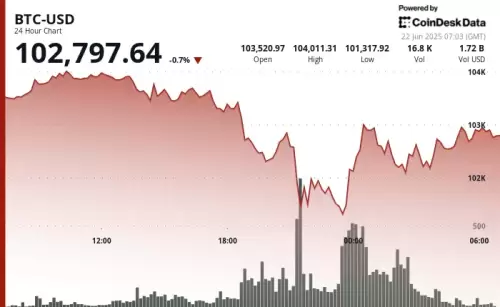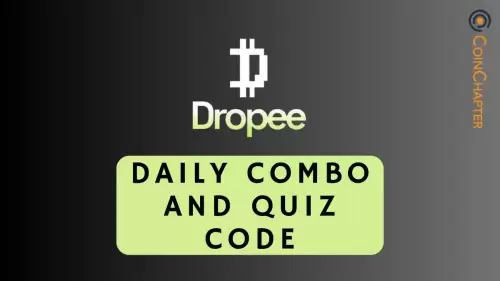 |
|
 |
|
 |
|
 |
|
 |
|
 |
|
 |
|
 |
|
 |
|
 |
|
 |
|
 |
|
 |
|
 |
|
 |
|
Cryptocurrency News Articles
Pi Network's Painful Plunge: The Rise and Fall of a Mobile Mining Project
May 16, 2025 at 06:16 pm
The cryptocurrency world witnessed another cautionary tale unfold as Pi Network, the much-hyped mobile mining project, saw its token price crumble

The cryptocurrency world is no stranger to hype cycles, but few projects have seen such a dramatic build-up of anticipation as Pi Network. The Stanford-born mobile mining project, which launched in 2019, promised to bring cryptocurrency to the masses through a minimal effort 'mining' system accessible through a smartphone app.
Over three years later, and with over 35 million users engaging in daily routines on the app to collect the Pi token, the project’s ‘enclosed mainnet’ period—where tokens couldn’t be traded on major exchanges—saw the token reach prices of $20-$100 on various gray markets.
But as institutions go, the startup has been slow to integrate with the broader crypto ecosystem. Despite rumors of an imminent open mainnet launch and potential exchange listings earlier in 2023, the Pi Core Team announced on June 15th a two-phase migration process for gradually converting Pi to an open network.
The announcement, which also touched upon KYC procedures and potential transfer limits for the token, was met with immediate disappointment from the community who had been anticipating more immediate launch details.
In the immediate aftermath, the brunt of the fallout was felt in the rapid collapse of gray market prices.
Before the announcement, the bulk of unofficial Pi trading was taking place in Telegram groups and smaller platforms, with the token changing hands at rates that varied wildly.
“The gray market prices were completely divorced from reality,” explains blockchain analyst Mark Jefferies of CryptoInsight.
“They reflected pure speculation based on promises rather than actual adoption or use cases. In essence, it was a classic case of a narrative-driven token, which becomes dangerous when the narrative shifts.”
This speculative bubble reached its peak in early 2023 when rumors swirled about an imminent open mainnet launch and potential exchange listings, pushing gray market prices to their all-time highs.
The stage was set for either a spectacular validation or a painful reckoning of the community’s high expectations.
However, the announcement on June 15th ultimately failed to deliver on the hopes of millions of Pi users. Instead of revealing launch details for major exchanges or full mainnet functionality, the Pi Core Team introduced a two-phase migration process that would gradually convert Pi from its current enclosed mainnet version to an open network.
Crucially, the announcement contained no timeline for when Pi would actually become tradeable on major exchanges, nor did it mention any partnerships with established platforms. This omission was particularly glaring given the rumors that had been circulating in recent months about pending listings on Binance, Huobi, and other leading exchanges.
The market reaction was swift and brutal. Within hours of the announcement, gray market prices collapsed by over 80% as disillusioned investors rushed to unload their holdings.
“It was like watching a slow-motion train wreck,” recalls Raj Patel, a Pi trader who lost nearly $15,000 in paper value.
“The Telegram groups went from celebratory mood to panicked selling within minutes. It was total chaos as people tried to offload their Pi at any price.”
Even more concerning were reports of a 400% increase in Pi-related scam complaints in the days following the announcement, according to blockchain forensics firm Chainalysis.
As disappointed community members grew desperate for any news of the token’s listing, several fake “Pi listing” websites and email scams emerged, preying on the community’s anxieties.
Several structural flaws in Pi Network’s model made this price collapse almost inevitable. Unlike traditional cryptocurrencies that derive value from network usage and scarcity mechanisms, Pi’s value proposition was almost entirely based on future promises.
The project’s unique “mobile mining” approach, while innovative, created billions of tokens with no real-world utility or use case outside of speculative trading.
“Pi Network fell into the classic trap of prioritizing user growth over token economics,” notes Dr. Sarah Zhang of the Blockchain Innovation Lab.
“By giving away tokens so freely through their mining app, they essentially guaranteed massive sell pressure whenever trading finally became possible.”
Compounding this problem was the project’s opaque governance structure and lack of transparency about the token distribution. Only 20% of the total token supply was allocated to users through the mining program, with the remaining 80% reserved for the core team, future development, and an initiative called the “Community Node Program.”
These structural weaknesses became more apparent when the promised “open market” launch failed to materialize in the announced next phase of the network. Despite hinting at the possibility of early access to a limited number of users, the statement made no mention of any specific plans for expanding the network or integrating it with major exchanges.
In the days following the price collapse, the Pi community fractured into various factions. Some loyalists remained optimistic, attributing the delay to the complexities of launching such a large-scale project. They
Disclaimer:info@kdj.com
The information provided is not trading advice. kdj.com does not assume any responsibility for any investments made based on the information provided in this article. Cryptocurrencies are highly volatile and it is highly recommended that you invest with caution after thorough research!
If you believe that the content used on this website infringes your copyright, please contact us immediately (info@kdj.com) and we will delete it promptly.






























































